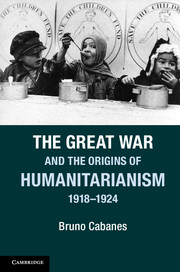Book contents
- Frontmatter
- Contents
- Acknowledgments
- Introduction Human disasters: humanitarianism and the transnational turn in the wake of World War I
- 1 “Rights, not charity”: René Cassin and war victims
- 2 Justice and peace: Albert Thomas, the International Labor Organization, and the dream of a transnational politics of social rights
- 3 The tragedy of being stateless: Fridtjof Nansen and the rights of refugees
- 4 The hungry and the sick: Herbert Hoover, the Russian famine, and the professionalization of humanitarian aid
- 5 Humanitarianism old and new: Eglantyne Jebb and children's rights
- Conclusion Human dignity: from humanitarian rights to human rights
- Further reading
- Bibliography
- Index
- References
Conclusion - Human dignity: from humanitarian rights to human rights
Published online by Cambridge University Press: 05 June 2014
- Frontmatter
- Contents
- Acknowledgments
- Introduction Human disasters: humanitarianism and the transnational turn in the wake of World War I
- 1 “Rights, not charity”: René Cassin and war victims
- 2 Justice and peace: Albert Thomas, the International Labor Organization, and the dream of a transnational politics of social rights
- 3 The tragedy of being stateless: Fridtjof Nansen and the rights of refugees
- 4 The hungry and the sick: Herbert Hoover, the Russian famine, and the professionalization of humanitarian aid
- 5 Humanitarianism old and new: Eglantyne Jebb and children's rights
- Conclusion Human dignity: from humanitarian rights to human rights
- Further reading
- Bibliography
- Index
- References
Summary
One morning in April 1921, the citizens of a small town in New England awoke to the sight of 2,000 white crosses, planted in rows on their town green. Each cross symbolized the imminent death of a child suffering from famine in Central Europe. A representative of the Hoover Committee waited behind a stand. For a donation of $10, he would remove a cross and replace it with an American flag. Within a week, the symbolic graveyard had become a sea of red, white, and blue flags.
Although it's impossible to say exactly what the individual donors felt as those crosses disappeared, the vision of the flags offered a strong symbol of lives saved by the power of charity. Those who chose to donate must have been moved by the thought of innocent children suffering in the chaos of the post-war period; they empathized with these children, no matter how little they knew about the faraway countries where they lived or the tragedies they had endured.
- Type
- Chapter
- Information
- The Great War and the Origins of Humanitarianism, 1918–1924 , pp. 300 - 313Publisher: Cambridge University PressPrint publication year: 2014



